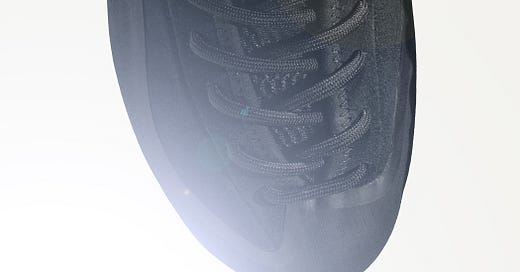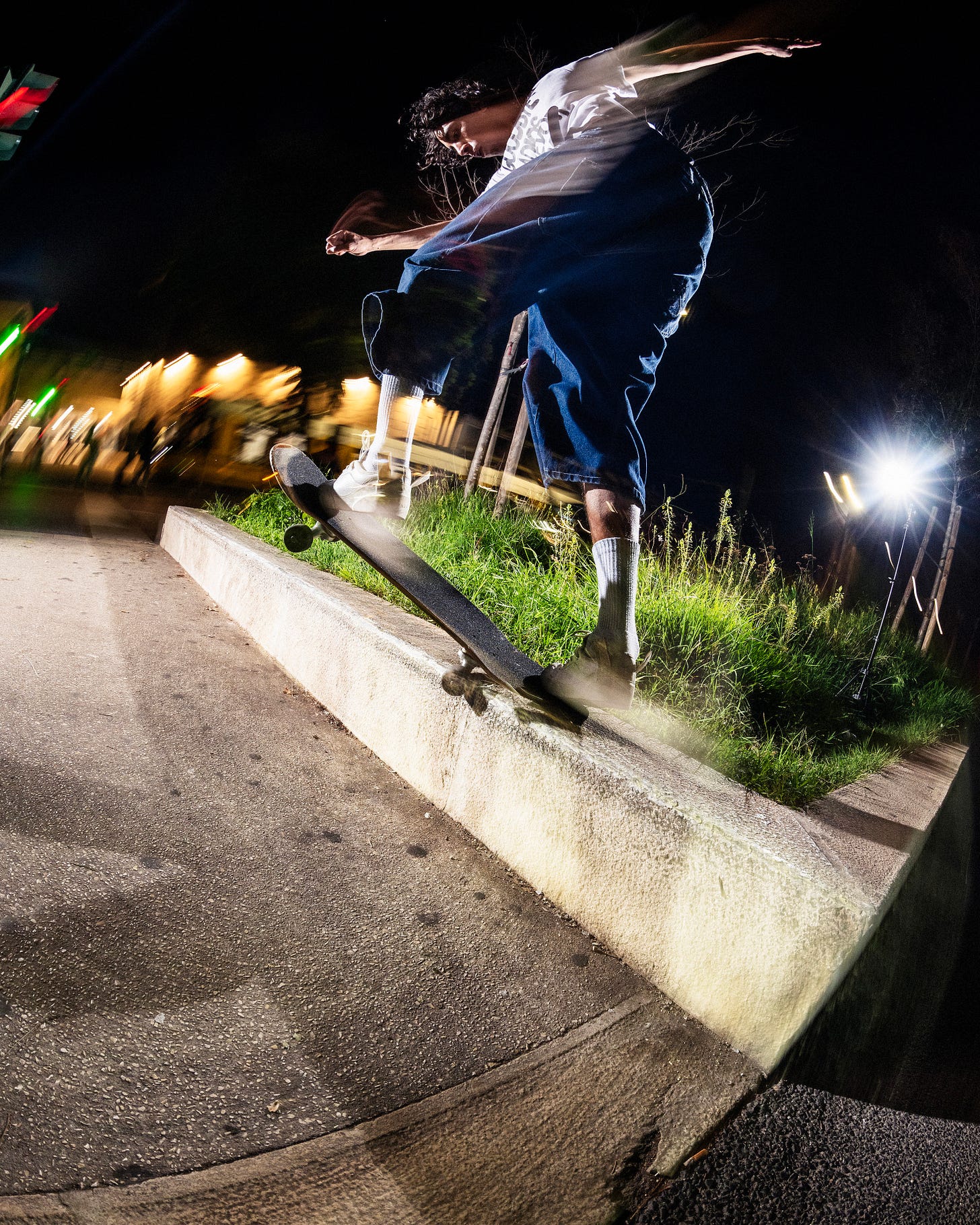Village PM Is Making Very Interesting Shoes
"What we're trying to do is find inspiration in other universes that aren't necessarily skate footwear."
“We feel that skateboarding footwear has been going around in circles for a while. There's some stuff happening, obviously, but we felt like there was room for a new proposition, something fresh to skate in.”
— Basile Lapray, co-founder of Village PM
“One of the things we see, with a lot of our friends, is that they started wearing skate shoes almost like [conventional] sports footwear in a way. You put skate shoes on before you go skating and then take them off right after and put on some dress shoes, running shoes, some outdoor shoes or whatever. When we were younger, or during other eras of skateboarding, that was much less the case.”
— Bram De Cleen, co-founder of Village PM
Village Psychic: It’s interesting. I'm going skating later today and I’m wearing skate shoes right now, but they're not the shoes I'm going to be skating in.
Bram De Cleen: Everybody is going to wear all kinds of different shoes, which of course is completely normal. But people aren't wearing skate shoes as much as they used to, however they are still very much down to show that they like skateboarding through their clothing. That shows that people are still proud to be affiliated to skateboarding, right? For us, the fact that skate shoes are being worn a lot less outside of the actual activity of skateboarding than before was a signal that made us think, like, something is missing in skateboarding’s footwear offering at the moment.
Skateboarding has opened up a lot over the last two decades, I would say, connecting with a lot of different universes — fashion being one of them — being less sectarian than it used to be, which can be a good thing. Being open to communicating with other activities whatever they are. What we're trying to do is that same thing but applied to skateboarding footwear. We’re trying to get inspired outside of skateboarding, find stuff that makes sense for skateboarding and try to offer something that's coming from that state of mind and is great to skate in.
Where does what you guys are making fit into that conversation?
Basile Lapray: It's basically [making] a shoe we feel proud to wear, a bit different than what we're used to seeing as “skate shoes”, maybe a bit more refreshing aesthetically, something that can evolve in different environments on the side and that’s more progressive in design. All the design is inspired by what we want in a skate shoe. How sticky should the rubber be? How fast does the shoe break in? We make all of the choices for functional reasons first and then we see if we’re happy with the vibe, the feeling, the design that it brings to the shoe.
Can you expand on the design process?
Basile: I worked in the footwear industry for a while before starting this project, working mostly with fashion outdoor brands. I started at Salomon as an intern years ago, helping out Julien Traverse, who is now our third partner in Village PM. The two of us have always been in that kind of outdoor footwear world in innovation, research and development, product marketing, and so on. Julien launched Salomon into the fashion space and was there for the start of Arcteryx footwear. Since then he's created a footwear development agency doing design, marketing, R&D and innovation, based in the French Alps.
I worked at that agency for, like, four years. I was responsible for collaborations and creative projects for different companies like The North Face and Paraboot, I was really into that. I'm not a big mountaineer or climber but I was working within a company and surrounded by dope mountaineering people. I learned so much in terms of outdoor product performance. As a skateboarder, I was seeing the parallels and cool functionality that we could maybe get inspired to put into a skate shoe. There were many things I'd become used to doing in the outdoor world that could be adapted or transferred into skating.
That was a big starting point. I mean, we're not a climbing or outdoor brand or whatever. We're 100% a skateboarding brand. But still, we take our inspirations in terms of designs and functionalities from that world. Skateboarding footwear has always been inspired [from outside], whether its by basketball shoes, boat shoes, Air Maxes or whatever. Looking at footwear genres and translating them into skateboarding shoes isn’t new. For now, we’re just doing it with another genre that hasn't been transferred into a skate shoe yet, which is the outdoor/climbing shoe.
Did the previous companies you worked for help launch Village PM in any way or you were just using their facilities?
Basile: As I was working in outdoor footwear innovation, we used to build precise mountaineering shoes for top athletes. Climbing shoes, approach shoes, basically an area of footwear where innovation is more advanced than in skateboarding. For Village PM, we wanted to have this precision that’s in outdoor sports like mountaineering, and so on, where people have to have their big toe able to to be really precise to reach certain rocks. Inspiration was coming from that, but transferred to skateboarding. We didn't want to have a round shape or pointy tip like the Converse One Star, for example, we wanted this more asymmetrical and anatomical fit so that's why we developed our own last. Making the last is the martial arts of footwear, it’s a really complex job, you have people that are specialized in that, so they really helped us out with that.
Bram: We also spent a lot of time finding the right rubber composition that was neither too hard, nor too soft, but durable and that has the right flick. That was a hard one to get right. Basically imagine gluing a bunch of different rubbers onto existing shoes and doing fifty kickflips, trying different formulas until we got to one where it’s too sticky for the first handful of kickflips, but then once you hit a good kickflip one, you know you'll have that same feeling for a long time.
It sounds like you're in a pretty enviable position by having connections in the right places in terms of actually getting things built and prototyped.
Bram: Yeah, the setup of who's working together and who brings what to the table, we're pretty good on that for now. We did get lucky with a bunch of stuff. Prototyping, building the last was the hardest part but without the people helping us out, if it was just the two of us, like it would we would have been nowhere near to what we have now.
When it comes down to the customer who is the brand for, who do you see that buys this?
Bram: I wouldn't say everyone within skateboarding. Obviously, there are people in skateboarding who know exactly what they want and it exists on the market. We're not here to convince the Half Cab guy to get out of wearing Half Cabs unless he's open to giving something else a try. We're down for everybody to try our shoe, but I guess the person that we're targeting would be those using skate shoes as a sporting shoe, and wearing a bunch of shoes elsewhere, because we know they're open to new aesthetics. I would say that would be the first person we think we're able to reach.
Two points on that as you talk about working with Salomon, specifically on their shoes: 1) the price point is a lot higher and 2) how many of those shoes do you actually see in a trail or a camping situation? They’re very much an urban phenomenon, you know?
Bram: Yeah, kind of like how a lot of Jordans never see an actual basketball court. Why do people wear outdoor stuff? People in urban environments often wear them because it reminds them of nice moments, I guess, a long walk they did in the forest or something. And then a lot of people like to wear outdoor shoes because they're really comfy and just enjoyable to wear.
Continued in Part 2 🧙








